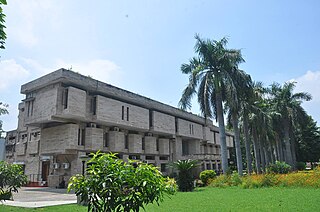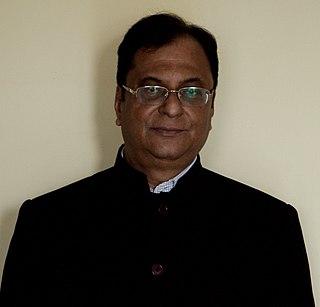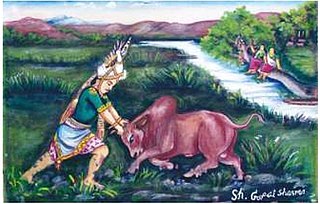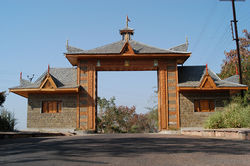
The Govind Ballabh Pant Social Science Institute (GBPSSI) is a research institute located in Jhusi in Prayagraj district of India. It is one of the 14 institutes establishments in India established by Indian Council of Social Science and Research.
Museum of Man may refer to:

Bhopal District is a district of Madhya Pradesh state in central India. The city of Bhopal serves as its administrative headquarters. The district is part of Bhopal Division.

The Ministry of Culture is the Indian government ministry charged with preservation and promotion of art and culture of India.

Bharat Bhavan is an autonomous multi-arts complex and museum in Bhopal, India, established and funded by the Government of Madhya Pradesh.The architect of the Bharat Bhavan is Charles Correa. Opened in 1982, facing the Upper Lake, Bhopal, it houses multiple art galleries, a graphic printing workshop, a ceramics workshop, an open-air amphitheatre, a studio theatre, an auditorium, a museum of tribal & folk art, and libraries of Indian poetry, classical music & folk music.
Gandhi Sangrahalaya is the name of several museums in India, most of them named after Mahatma Gandhi. It may refer to:
Chapa or Chap is a clan of the Gurjar ethnic community of northern India.
Vejalka is a village in the Ranpur Taluka of Botad district in Gujarat, India. An Indus Valley Civilisation archeological site was found and excavated near this village in 2014.

Kalyan Kumar Chakravarty is an Indian historian, art historian, writer, action anthropologist, academician and administrator, known for his intercultural and cross-disciplinary research and activism. A retired officer of the Indian Administrative Service (IAS) of the 1970 batch, he was appointed Chairman of the Lalit Kala Akademi, India’s federal fine arts academy, in 2013.

Durga Bai Vyam is an Indian artist. She is one of the foremost female artists based in Bhopal working in the Gond tradition of Tribal Art. Most of Durga's work is rooted in her birthplace, Barbaspur, a village in the Mandla district of Madhya Pradesh.

Bhuri Bai is an Indian Bhil artist. She was born in Pitol village, situated on the border of Madhya Pradesh and Gujarat. Pitol is a village of Jhabua district in Madhya Pradesh. Bhuri Bai belongs to the community of Bhils, the largest tribal group of India. She has won many awards including the highest state honour accorded to artists by the Madhya Pradesh government, the Shikhar Samman. She was awarded India's fourth highest civilian award the Padma Shri in 2021.

Poubi Lai was an ancient dragon python, who dwelled in the Loktak Lake of Manipur, in Meitei mythology and folklore. It is also referred to as "Loch Ness Monster of Manipur".

Tikla, or Tikula, is an archeological site and ancient rock shelter in Madhya Pradesh, India, known for its petroglyphs. Tikla is situated around 170 km (110 mi) south of Mathura and 50 km (31 mi) southwest of Gwalior on the Agra to Mumbai road near the town of Mohana on the right bank of the Parvati river.

Kao is a legendary divine bull captured by Khuman Khamba in Meitei mythology and folklore of ancient Moirang realm. It appears in the legend of Kao Phaba, also known as Khambana Kao Phaba of the Khamba Thoibi epic.

The Khambana Kao Phaba is a 2001 oil canvas painting by Manipuri artists, M Betombi Singh and Gopal Sharma. The painting shows the capture of powerful Kao bull by hero Khamba. It is one of the most well known museum series "Exhibit of the Month" of the Indira Gandhi Rashtriya Manav Sangrahalaya in India. It was exhibited for a whole month of July, 2019.

The Kangla Sanathong, also known as the Kangla Gate, is the western entrance gate to the Kangla Fort in Imphal West district of Kangleipak.

The Tribal Museum of Bhopal or Madhya Pradesh Tribal Museum is located close to the State Museum, Bhopal, near the Museum of Man/ Museum of Mankind in the Indian state of Madhya Pradesh. This is a museum dedicated to the living aspects of tribal life, indigenous knowledge systems, and aesthetics.

The ancient legend of Khamba and Thoibi is a classic, as well as one of the epic cycles of incarnations of Meitei mythology and folklore, that is originated from Ancient Moirang kingdom of Ancient Kangleipak . It is referred to as the "National Romantic Legend of Manipur" by Padma Vibhushan awardee Indian scholar Suniti Kumar Chatterjee.

















